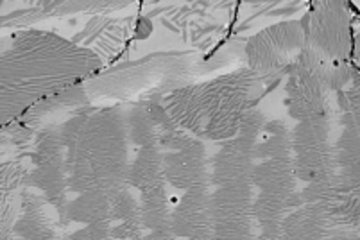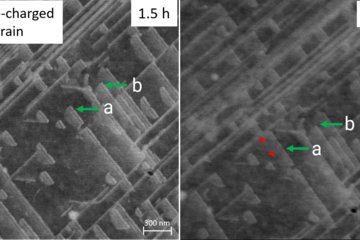All genres
2081.
Talk
Investigation of Nano Indentation Pile-Up Patterns in Copper Single Crystals. Euromat 2003, Lausanne, Schweiz (2003)
2082.
Talk
Polycrystal Mechanics in Experiment and Theory. Keynote lecture at the Breitnau Materials Conference, Breitnau (2003)
2083.
Talk
Polycrystal Mechanics in Experiment and Theory. NATO Conferece, Freiburg (2003)
2084.
Talk
Microstructure mechanics: Investigation on deformation behaviour of grain boundaries. Plasticity 2003 (Keynote lecture), Québec, Canada (2003)
2085.
Talk
Polycrystal Mechanics in Experiment and Theory. Meeting, Massachusetts Institute of Technology, Cambridge, USA (2003)
2086.
Talk
Texture Conference. Modern Texture Research on Engineering Materials, MPIE, Düsseldorf, Germany (2003)
2087.
Talk
Experiment und Theorie der Oberflächen- und Polykristallmechanik. Kolloquiumsvortrag an der Technischen Universität, Hamburg-Harburg (2003)
2088.
Talk
Experiments and Theory of Surface- and Polycrystal Mechanics. Colloquium Lecture at the Technical University of Hamburg-Harburg, Hamburg-Harburg (2003)
2089.
Talk
Texturen und Kristallmechanik. Kolloquium, TU Darmstadt (2003)
2090.
Talk
Textures and Crystal Mechanics. Colloquium Lecture at the Materials Department at the Technical University of Darmstadt, Darmstadt (2003)
2091.
Talk
Slip system determination by rolling texture measurements around the strength peak temperature in a Fe3Al-based alloy. Intern. Conf. on Strength of Materials (ICSMA 13), Budapest, Hungary (2003)
2092.
Talk
Experimental and Theoretical Investigation of Grain Scale Plasticity. Colloquium lecture at the Department of Materials Science and Engineering of Northwestern University, Evanston, Chicago, USA (2002)
2093.
Talk
Moderne Simulationskonzepte für den Werkstoff Stahl und seine Anwendungen. VDEh Werkstoffausschuss, Düsseldorf (2002)
2094.
Talk
Computational Materials Science. Colloquium lecture at GKSS Research Center, Geesthacht, Germany (2002)
2095.
Talk
A Texture Component Crystal Plasticity Finite Element Method for Scalable Large Strain Anisotropy Simulations. ICOTOM 13, Seoul, South Korea (2002)
2096.
Talk
Theory of Orientation Gradients. ICOTOM 13, Seoul, South Korea (2002)
2097.
Talk
Modelling Applied to Aluminium Alloy Metallurgy. Keynote lecture at the 8th International Conference on Aluminium Alloys (ICAA-8), Cambridge, UK (2002)
2098.
Talk
Polycrystal Mechanics. Colloquium at the National Institute for Standards and Technology NIST, Washington, D.C., USA (2002)
2099.
Talk
Simulation of Recrystallization. Colloquium lecture at Wright Patterson Research Center, Dayton, Ohio (2002)
2100.
Talk
Polykristallplastizität. Kolloquium an der Fakultät für Werkstoffwissenschaften der Universität Erlangen-Nürnberg (2002)











